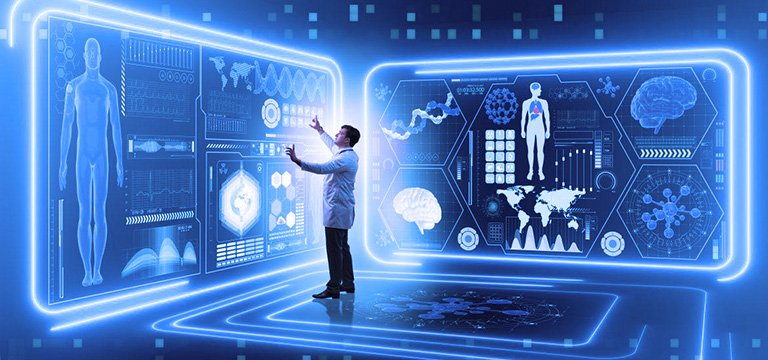Artificial Intelligence (AI) In Healthcare
- 15th November, 2024
- 0 Comments
- 418
- Healthcare
Artificial intelligence (AI) is revolutionizing the field of medical diagnostics, offering faster, more accurate, and efficient ways to detect and diagnose diseases. By harnessing the power of algorithms and machine learning, AI systems analyze medical data—from imaging scans to genetic information—at a level and speed previously unimaginable. Here’s a look at how AI is transforming diagnostics and the potential benefits, challenges, and future implications of this technology.
1. AI in Radiology and Imaging: AI has made substantial strides in radiology, with algorithms now capable of detecting abnormalities in X-rays, CT scans, MRIs, and mammograms. By using deep learning, AI systems can recognize patterns indicative of diseases such as cancer, stroke, and neurological conditions. For example: Breast Cancer: AI can detect breast cancer in mammograms with high accuracy, sometimes identifying subtle signs that even trained radiologists might miss. Lung Disease: AI algorithms can analyze chest X-rays for lung diseases, including pneumonia, tuberculosis, and, more recently, COVID-19. Stroke Detection: In emergency settings, AI can detect stroke signs in brain scans within seconds, enabling doctors to start life-saving treatments faster.
2. Pathology and Histopathology: In pathology AI systems are trained to analyze tissue samples to detect cancerous cells, genetic abnormalities, and other disease markers. Digital pathology platforms enable AI to examine large numbers of slides, assisting pathologists in identifying diseases like skin cancer, prostate cancer, and liver disease. Cancer Diagnostics: AI in pathology can identify specific mutations in cells, helping doctors diagnose cancer types and determine treatment options with more precision. Biopsy Analysis: For complex biopsies, AI helps pathologists pinpoint areas of concern, potentially increasing diagnostic accuracy and reducing the time required for assessment.
3. Cardiology and Cardiac Imaging : AI-driven tools in cardiology are transforming how heart disease is diagnosed and managed. Algorithms are used to analyze echocardiograms, ECGs, and cardiac MRIs, detecting conditions like arrhythmias, valve diseases, and blockages.
4. Genomics and Precision Medicine : AI plays a crucial role in genomics, where it analyzes genetic data to identify mutations and genetic markers linked to diseases. This is especially important for diagnosing rare genetic disorders and for personalized medicine. Cancer Genomics: AI algorithms can process large genomic datasets to find cancer-driving mutations, helping oncologists personalize treatment plans. Rare Diseases: AI tools can rapidly sequence and interpret genetic information to diagnose rare genetic disorders, which can be life-saving in early childhood or critical cases.
5. Ophthalmology and Retinal Imaging: AI is also making significant inroads in ophthalmology, particularly for the early detection of conditions such as diabetic retinopathy and age-related macular degeneration.
6. AI for Infectious Disease Diagnostics: AI models have been developed to aid in the diagnosis of infectious diseases, from identifying bacterial versus viral infections to tracking the spread of pandemics.
Benefits of AI in Medical Diagnostics: -
Improved Accuracy: AI can reduce diagnostic errors by consistently analyzing large amounts of data and identifying complex patterns that might be missed by human eyes.
Efficiency and Speed: AI systems can rapidly process data, allowing for faster diagnoses, especially crucial in emergency settings.
Enhanced Access to Diagnostics: In underserved or rural areas, AI-powered diagnostics can help bridge the gap by offering high-quality assessments without the need for specialized radiologists or pathologists.
Challenges and Ethical Concerns:-
Data Privacy and Security: Handling sensitive patient data raises concerns about privacy, data security, and the potential for misuse.
Algorithm Bias: AI algorithms are trained on historical data, which may introduce biases that could lead to disparities in diagnostic accuracy for different demographic groups.
Reliability and Liability: Although AI is powerful, its predictions may not always be accurate. Determining accountability when AI makes a mistake is a complex issue, particularly in life-or-death situations.
Conclusion:- AI is transforming medical diagnostics by increasing the speed, accuracy, and accessibility of healthcare. While challenges remain—especially regarding ethics, data security, and reliability—AI’s potential to improve patient outcomes is profound. By continuing to develop AI responsibly and ethically, the healthcare industry can harness its power to revolutionize diagnostics and, ultimately, save lives.






No Comments For Now.